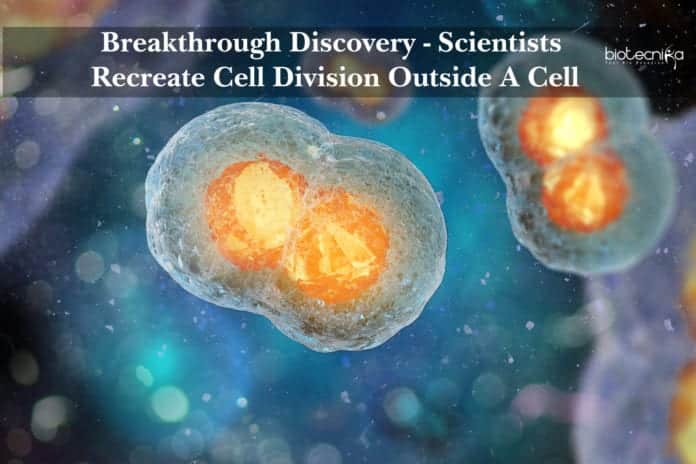Scientists Recreate Cell Division Outside A Cell
With the advancement of science, loads of mysteries of life have been unveiled by scientists. But at the fundamental ground level, researchers are still trying to analyze the core process behind How our own cells build, move, split and transport.
Margaret Gardel, a professor of physics at the University of Chicago headed an innovative study, under which for the first time scientists have successfully recreated the mechanism of cell division – outside a cell. The experiment, led by postdoctoral fellow Kim Weirich and published May 21 in the Proceedings of the National Academy of Sciences, helps scientists understand the physics by which cells take out their regular tasks, and could one day lead to medical breakthroughs, ideas for new kinds of substances as well as artificial cells.
“How cells divide is one of the most basic facets of trying to create life, and it is something we’ve been trying to comprehend for centuries,” said study senior author Gardel, that unites physics and biology to study the methods by which cells change themselves.
Cells locomote through the body, but some of the very complicated motion happens inside the cell itself, as it ships ingredients
and supplies from place to place, flattens or expands, and divides to recreate itself. Among the critical players in this biological process is actin, a protein which assembles itself into rods and structures.Gardel’s team wanted to know the physics behind the actions of actin. So Weirich turned into one of the chief ways that scientists have for this question: choose the ingredients and try to assemble together outside the cell.
Weirich separated out actin proteins and observed as they shaped droplets that took on an almond shape. When Weirich inserted myosin (“motor” proteins shared in muscles), they found the center between the two endings of the droplet and pinched off the droplet into two.
They were totally shocked to see the procedure, Gardner said. “There is no precedent for it. It looks exactly like the spindles that induce cell division.”
Gardener long with Thomas Witten – University of Chicago physicist and Suriyanarayanan Vaikuntanathan, postdoctoral fellow Kinjal Disbaswas together turned this model into action.
Myosin molecules (white) gather in the center of the rod-like actin molecules (red). (Courtesy of Weinrich et al)
The rod-like actin molecules when in a droplet gets into parallel alignment to minimize conflict, forming the almond shape. The more myosin molecules prefer to assemble at the center so they can still remain parallel to the actin. But as more myosins gather, they begin to stick together, forming clusters that favor tilting instead of remaining parallel-so it pinches off into two. It’s the first such detailed look at the way the cell might accomplish this task.
Seeing this procedure –just how living things tap the construction of a droplet to form more life–is not just interesting but practical, Gardner said. “This is the kind of thing that you want to learn to envision building things like artificial tissue for a wound,” she said.
This article was adapted from a post at UChicago News.






























